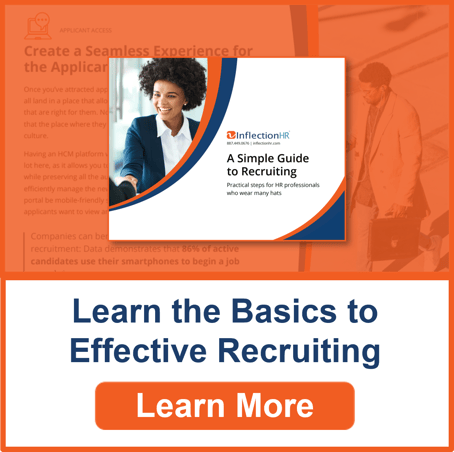First impressions with a new hire are essential, and employing a hiring process that is unnecessarily drawn out can create negative first impressions. It’s not uncommon for organizations to struggle with establishing an efficient hiring process, getting caught up in endless interviews and deliberations. Often, this stems from the sentiment of wanting to hire the right candidate. However, the unintended consequence is that quality candidates withdraw from candidacy, and roles remain vacant for extended periods.
While there is no perfect solution for every organization or role, employing strategies that streamline decision-making, garner consensus, and provide an essential step-by-step guideline for the hiring process can accelerate new hires and fit quality individuals into key roles. Let's take a closer look at seven proven techniques to streamline the hiring process.
1. Write Effective Job Descriptions
Write your job descriptions for clarity. Be detailed and descriptive, while also eliminating frivolous information. When someone applies, you want them to fully understand the scope of the role, the needs of the organization, and the baseline requirements for being effective in the role. A common structure that organizations follow includes sections: About the Company, About the Role, Key Responsibilities, Core Skills and Competencies, Baseline Requirements, and Additional Requirements. The requirements section is also a useful place to state which requirements are must-have vs. nice-to-have, encouraging people to apply even if not every single requirement is met.
Many states require pay transparency by law, but even if you’re operating in a state that doesn’t mandate pay transparency, consider including it to help candidates better self-select prior to applying.
Consider what you could infer from the description if you were the job seeker, to ensure an attractive and informative listing.
2. Choose the Correct Job Boards
Know your job boards. Boards like Indeed and LinkedIn are universal, but other job boards are tailored to individual industries and types of professionals. Select the right combination of broad and niche job boards for the reach you desire.
Use each job board to the fullest. Fill out all the form sections so that the sorting mechanisms available on each job board optimize visibility and accessibility for job seekers on each platform.
Take note of categorizations such as 'Remote' or 'Entry-Level' vs 'Senior' to properly categorize each role and attract self-screening candidates who know a good match when they see it.
3. Use the Right Talent Acquisition Solution
Tracking and evaluating applicants is critical to an efficient hiring process. Using a cloud-based talent acquisition solution that provides real-time access to everyone involved in the hiring process can increase the flow of key information and make communication more efficient. It can also make it easier to access tools, such as background checks, job history verification, and credit checks, to help screen applicants.
A solution that provides mobile device access, real-time or near-real-time access, and allows for easy cross-tracking can dramatically increase the efficiency of the hiring process.
4. Provide Prompt and Responsive Communication
Don't leave your candidates hanging. Set a response time goal and stick to it. Time wasted not getting back to candidates is time that your organization can not get back. This is extra important for candidates with the most potential.
Throughout the interview process, prompt responsive communication is important, and so is the quality of information provided. Work to ensure that you are providing complete information about the organization, the role, the team, and the environment. For example, you would want to provide enough details for remote candidates to ensure aspects of employment, such as pay, benefits, and potential immigration law hurdles, are addressed and met with promptly. This information is critical to marrying expectations with reality when that candidate becomes an employee.
Avoid being seen as a company that ignores applications if you want to keep receiving applications and hang onto your best candidates through the entire hiring process.
5. Streamline the Interview Process
Though role-dependent, consider how many rounds of interviews need to be conducted in order for all key interviewers to participate. No matter what role the organization is hiring for, the goal should nearly always be to move through the process in a timeline that parallels when the hire should be made. In other words, if the role was needed yesterday, having a 5-round process that takes 2 months on average is probably not going to suit the organization and the team that the role resides within. Extended interview processes have a high chance of discouraging candidates and running the risk of the best candidates withdrawing from the process altogether.
6. Consider Internal Referrals
Internal hiring candidates referred by trusted employees can be a great way to accelerate your process, particularly for organizations that have continuing education, cross-training, and mentorship programs. It’s possible to dramatically reduce the interview and screening processes when a current employee is able to fill a vacancy.
This doesn’t mean that the individual won’t need to interview, but it’s possible to reduce the steps, shrink the timelines, and reduce or remove any background screening.
7. Keep Track of Runners-Up as Future Hires
Lastly, keep the contact information of leading candidates and be considerate in declining those who are not chosen for the current role. Runners-up are still valuable professionals who may make excellent future hires.
Keep in touch on LinkedIn and invite them to apply with pre-screened favor for any jobs that suit their already established skill sets. It’s possible to save significant time by interviewing candidates who have already been through steps in the process. Maintaining a quality connection between high-performing candidates can help you avoid making a costly hiring mistake by starting the process all over again.
Streamline Your Hiring Process with Cloud-Based Hiring Solutions
We are here to help. Whether you’re looking for talent acquisition solutions or professional guidance on the process, contact us to learn how we can help you hire the best talent faster.


